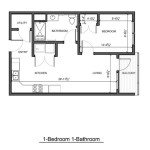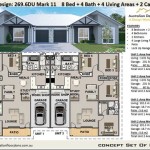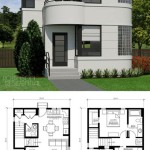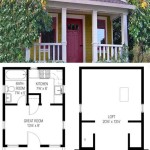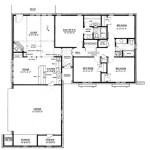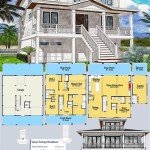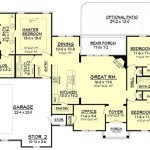Three-Story House Plans for Narrow Lots: Maximizing Space and Style
Urban development frequently presents the challenge of limited land availability, often necessitating the construction of homes on narrow lots. Three-story house plans offer an effective solution for maximizing living space within these constraints. By building vertically, homeowners can achieve a comfortable and functional residence without compromising on features or amenities. This article will explore the key considerations, advantages, and design elements associated with three-story house plans specifically tailored for narrow lots.
Understanding the Constraints of Narrow Lot Construction
Building on a narrow lot introduces specific architectural and structural challenges that must be carefully addressed during the planning and design phase. Setback requirements, which dictate the minimum distance a structure must be from property lines, significantly impact the buildable area. Additionally, narrow lot construction often necessitates creative solutions for access, utility placement, and drainage.
Zoning regulations play a crucial role in determining the feasibility of a three-story structure. Height restrictions, floor area ratios (FAR), and lot coverage limitations can constrain the overall design and must be thoroughly investigated before committing to a particular plan. Local building codes also govern aspects like fire safety, structural integrity, and accessibility, which must be incorporated into the design from the outset.
Given these constraints, careful site analysis is paramount. This analysis should encompass not only the physical dimensions of the lot but also its orientation relative to the sun, prevailing winds, and adjacent properties. Understanding these factors helps optimize the building's energy efficiency, natural lighting, and privacy. Furthermore, soil conditions and the presence of underground utilities must be assessed to determine the appropriate foundation design and minimize potential construction complications.
Successful narrow lot construction requires close collaboration between architects, engineers, and contractors. The architect's role is to translate the homeowner's vision into a functional and aesthetically pleasing design that complies with all applicable regulations. The engineer ensures the structural integrity of the building, particularly given the vertical nature of a three-story structure and the potential for soil instability on narrow lots. The contractor manages the construction process, adhering to the design specifications and ensuring that the project is completed on time and within budget.
Advantages of Three-Story House Plans on Narrow Lots
The primary advantage of a three-story house plan for a narrow lot is the maximization of living space. By expanding upwards, homeowners can achieve a significantly larger square footage compared to traditional single-story or two-story homes on comparably sized lots. This increased space allows for more bedrooms, bathrooms, living areas, and storage, catering to the needs of larger families or individuals who desire ample room for various activities.
Beyond spatial efficiency, three-story homes often offer enhanced views, particularly in urban or scenic locations. The elevated height can provide unobstructed perspectives of the surrounding cityscape, natural landscapes, or waterways. Strategic placement of windows and balconies can further capitalize on these views, creating a desirable and valuable feature.
Three-story designs can also contribute to improved privacy. The increased height allows for greater separation between the home and adjacent properties, reducing noise and visual intrusion. The placement of bedrooms on upper floors can further enhance privacy, creating a more tranquil and secluded living environment.
The inherent design flexibility of a three-story structure allows for distinct zoning of living spaces. For example, the ground floor may be dedicated to entryways, garages, and recreational areas, while the second floor houses the main living areas, kitchen, and dining room. The upper floor can then be reserved for bedrooms, bathrooms, and home offices, creating a clear separation between public and private spaces. This vertical zoning can significantly improve the functionality and flow of the home.
From a financial perspective, building a three-story home on a narrow lot can be a more cost-effective solution than purchasing a larger, wider lot in a more suburban location. The cost per square foot may be lower due to the efficient use of land. Furthermore, the increased density can contribute to lower property taxes in some areas. However, it's essential to carefully consider all costs associated with vertical construction, including foundation work, framing, and elevator installation (if desired), to accurately assess the overall financial implications.
Key Design Elements for Narrow Lot Three-Story Homes
Given the limited footprint of a narrow lot, efficient space planning is critical for a successful three-story design. Open-concept layouts can create a feeling of spaciousness by eliminating unnecessary walls and allowing natural light to flow freely throughout the home. Strategic use of vertical space, such as built-in shelving, storage niches, and soaring ceilings, can further enhance the sense of openness.
Natural light plays a vital role in making a narrow home feel brighter and more inviting. Large windows, skylights, and light wells can be incorporated to maximize daylight penetration. The orientation of the building should be carefully considered to optimize solar gain and minimize reliance on artificial lighting. The selection of light-colored interior finishes and reflective surfaces can also amplify the effects of natural light.
Staircase design is particularly important in a three-story home. The staircase should be functional, safe, and aesthetically pleasing. Careful consideration should be given to its placement, width, and materials. A well-designed staircase can serve as a focal point, adding character and visual interest to the home. Alternatively, homeowners might explore the option of installing an elevator or a stair lift to improve accessibility, especially for older adults or individuals with mobility limitations.
Exterior design considerations are crucial for maximizing curb appeal on a narrow lot. Vertical siding, tall windows, and strategically placed balconies can accentuate the height of the building and create a visually appealing facade. The use of contrasting materials and colors can add depth and dimension to the exterior. Landscaping can also play a significant role in enhancing the curb appeal of a narrow lot home. Vertical gardens, window boxes, and strategically placed trees can add greenery and soften the appearance of the building.
The choice of materials is a key factor in determining the overall aesthetic and durability of a three-story home. Durable, low-maintenance materials are particularly well-suited for narrow lot construction, as they minimize the need for frequent repairs and upkeep. Sustainable building materials, such as reclaimed wood, recycled content insulation, and energy-efficient windows, can also contribute to a more environmentally friendly and cost-effective home.
Accessibility considerations should be incorporated into the design to ensure that the home is accessible to individuals of all ages and abilities. This may involve incorporating features such as wider doorways, ramps, grab bars, and adaptable kitchen and bathroom layouts. Universal design principles can be applied to create a home that is both functional and inclusive for everyone.
Outdoor living spaces, such as balconies, roof decks, and small courtyards, can significantly enhance the enjoyment of a narrow lot home. These spaces provide opportunities for relaxation, entertainment, and connection with nature. Careful planning is essential to maximize the functionality and privacy of these outdoor areas. Screening elements, such as trellises, privacy fences, and landscaping, can be used to create a sense of seclusion and separation from neighboring properties.
Integrating smart home technology can enhance the convenience, security, and energy efficiency of a three-story home. Smart lighting systems, automated window shades, and remotely controlled thermostats can significantly reduce energy consumption and improve comfort. Security systems with remote monitoring capabilities can provide peace of mind and deter intruders. Voice-activated assistants can be used to control various aspects of the home, making it easier to manage everyday tasks.
Addressing the unique challenges and opportunities presented by narrow lots requires careful planning, innovative design, and close collaboration between all stakeholders. By understanding the constraints, leveraging the advantages, and incorporating key design elements, homeowners can create a three-story residence that is both functional and aesthetically pleasing, maximizing the potential of their narrow lot.

Three Y Narrow Lot House Plans Google Search

Three Y Narrow Lot House Concept Ulric Home

Slim And Practical Three Story House In Narrow Lot Pinoy Designs

Plan 058h 0023 The House

Plan 51664 3 Story Narrow Lot Modern House

Nice Narrow Home Plans 3 Lot Plan House Designs

Plan Kd 9445 3 Three Story Bed Modern House For Narrow Lot

Plan 056h 0005 The House

Farmhouse Style House Plan 4 Beds 2 5 Baths 2515 Sq Ft 497 Cottage Plans Narrow Lot Beach

Plan Sp 84903 2 Three Story Bedroom Modern House With Split Bedrooms For Narrow Lot


